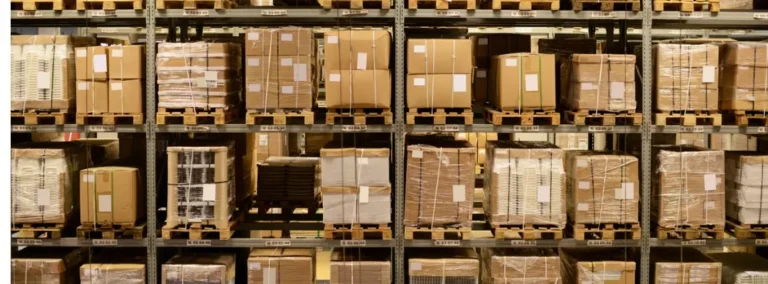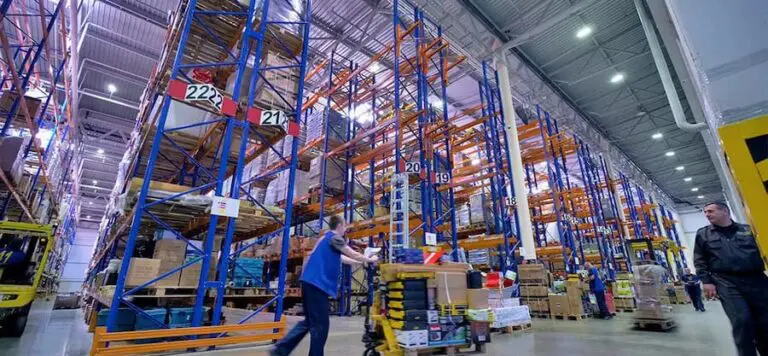Manage Challenges in Furniture Logistics with a 3PL
Furniture sellers rely on robust logistical strategies to get their products to customers. The process of selling and delivering furniture differs significantly from the methods used in smaller commercial transactions such as apparel and consumer packaged goods. Sellers may store and ship furniture in large sizes, from assembled bookcases to whole dining room sets. These large pieces require a significant amount of storage space and appropriate transportation options. Furniture fulfillment also comes with greater liability due to the higher risk of damage during the last-mile delivery process.
Sellers have several options when it comes to furniture storage. Ecommerce sellers may choose to skip the warehouse space, and instead ship orders directly from the manufacturer. Or, the seller may opt to use a third-party furniture fulfillment warehouse or distribution center (3PL or 3PF), to store and ship their products whenever orders are placed.
Below, we review the various components of the furniture fulfillment process, the challenges of furniture logistics, and how using a furniture 3PL helps you avoid some of these obstacles.
Furniture Freight Services
Furniture freight companies and brokers transport products from sellers to showrooms, distribution centers, and customers. Freight companies own trucks and employ the drivers who operate them. Brokers act as mediators, matching sellers with suitable carriers, negotiating rates, and managing the shipment.
The Role of Furniture Freight Brokers
Furniture freight brokers act as intermediaries between furniture retailers and freight carriers. They don’t own trucks but connect sellers with suitable carriers based on factors like shipment size, delivery timeframe, and cost. Their key responsibilities include:
● Finding carriers: Identifying freight carriers that can handle the retailer’s specific needs.
● Negotiating rates: Obtaining competitive freight rates from carriers.
● Managing shipments: Overseeing the entire transportation process from pickup to delivery.
● Handling claims: Assisting with filing and processing claims for damaged goods.
Furniture freight brokers arrange transportation from one location to another and are not involved with warehousing or inventory management.
Using a Furniture 3PL for Freight Brokerage Services
Working with a Furniture 3PL for freight brokerage services can significantly enhance operations and efficiency for furniture sellers by handling additional services beyond just transportation of products. With a network of warehouse locations, 3PLs offer warehousing, inventory management, and fulfillment services.
Outsourcing these services to a 3PL offers furniture sellers scalability to handle seasonal fluctuations and business growth, while also providing cost savings through bulk discounts and optimized warehouse space.
Advanced technology, such as inventory management and automated order fulfillment systems, further streamline operations and reduce errors. Additionally, 3PLs ensure regulatory compliance, improve customer experience through faster delivery and reliable tracking, and mitigate risks like damage and theft.
Partnering with a reputable Furniture 3PL can provide numerous benefits, allowing furniture sellers to optimize their operations, reduce costs, and enhance overall business performance.
Types of Furniture Freight
Less Than Truckload (LTL) Furniture Shipping
LTL is a shipping method that is ideal for furniture items that are too large for parcel delivery and is used when you are not shipping enough to fill an entire truck. Multiple shipments from different senders are combined into a single truck, sharing the transportation cost. This option is often more cost-effective than full truckload shipping for smaller furniture items.
Benefits of LTL Furniture Shipping for Sellers
LTL shipping is a lower cost furniture fulfillment alternative to full truckload shipping for businesses who need to send smaller or less frequent shipments. LTL provides flexibility in shipment sizes and quantities, allowing sellers to adapt to varying customer demands and inventory levels. This shipping method also expands market reach as LTL carriers serve a wider range of locations.
Full Truckload (FTL) Furniture Shipping
FTL furniture shipping involves dedicating an entire truck to a single shipment. This method is ideal for large furniture orders that can fill up a truck or nearly fill it. While typically more expensive than LTL, FTL is often more cost-effective for large shipments and often enhances customer satisfaction.
Benefits of FTL Furniture Shipping
By dedicating an entire truck to a single shipment, furniture sellers enjoy faster transit times as there are no stops for other deliveries. This direct approach also minimizes the risk of damage as the furniture is handled less frequently. Furthermore, FTL shipments often provide greater control over the transportation process, allowing for precise scheduling and routing. While the upfront cost is typically higher than LTL, FTL can be more cost-effective for large furniture orders due to the absence of additional fees commonly associated with shared truckload shipments.
Small Parcel Furniture Shipping
Small parcel shipping is a crucial method for delivering small furniture items to customers. This process involves breaking down larger shipments into smaller, manageable packages that can be handled and transported efficiently by carriers like FedEx, UPS, or the USPS. Furniture items that typically fit within small parcel dimensions include chairs, stools, small tables, and decorative accessories. These parcels typically weigh less than 70 pounds and measure less than 108 inches in combined dimensions.
After orders are prepared for shipping, they are transferred to the carrier who then consolidates them with other parcels and batches them for doorstep delivery. Small parcel shipping offers several advantages for furniture sellers, including faster delivery times, lower shipping costs compared to larger freight shipments, and the ability to track packages throughout the delivery process.
Benefits of Small Parcel Furniture Shipping
Small parcel shipping allows for faster, less expensive delivery services compared to larger freight shipments. It offers flexible options such as expedited and international delivery and customers can easily track orders online and know when to expect their items to arrive. Small parcel shipping is a convenient and efficient way for furniture sellers to deliver smaller items to customers, helping to improve customer satisfaction and reduce shipping costs.
White Glove Furniture Delivery
White glove furniture delivery is a premium service that offers a more personalized and hands-on approach to delivering larger, more delicate furniture items. Unlike standard delivery methods, white glove services involve professional delivery teams who carefully transport, unpack, and assemble the furniture at the customer’s specified location.
White glove delivery often includes on-site assembly according to the manufacturer’s instructions, placement of the furniture in the desired location within the customer’s home, and disposal of packaging materials. This service may include the removal of old furniture that is being replaced, as well.
Benefits of White Glove Delivery
White glove delivery offers numerous benefits to furniture sellers, including enhanced customer satisfaction, reduced returns, increased sales, improved brand reputation, and a competitive advantage. By providing a personalized and professional service that includes in-home assembly and placement, white glove delivery can help furniture sellers create a positive customer experience, minimize damage, attract premium customers, and differentiate themselves from competitors.
Common Furniture Logistics Challenges
Here are some of the challenges that impact furniture logistics:
- Rising Costs: Prices of everything are up, from raw materials to transportation to labor, impacting profitability for retailers and manufacturers in an industry where margins are already thin.
- Fluctuating Demand: Economic uncertainty, rising interest rates and shifting preferences have resulted in demand swings which make it difficult to accurately forecast and manage inventory.
- Evolving Consumer Expectations: Buyers expect fast delivery (of a blemish-free product), personalized experiences, and sustainable products, pressuring furniture businesses to adapt or fail. Those who can deliver a quality product, minimize damage and returns and maintain a reasonable margin will come out ahead.
Addressing these Challenges
Furniture businesses may mitigate the effects of these challenges by employing the following strategies:
Diversification of Supply Chains
Reducing reliance on a single supplier or region may bring multiple benefits. Contracting with new suppliers may ease pricing pressure and mitigate the impact of disruptions.
Demand Forecasting
Demand forecasting, based on market research and advanced analytics, facilitates proactive decision-making, such as adjusting pricing strategies or developing new product lines to meet changing consumer demands. Demand forecasting is essential for furniture businesses to stay competitive, adapt to market changes, and ensure long-term survival in an increasingly dynamic and competitive industry.
Inventory Optimization
Utilizing advanced inventory management systems is essential, and adopting a Just-in-Time (JIT) approach can help businesses maintain optimal stock levels while minimizing costs. JIT inventory is a management strategy in which products and materials are ordered and received by a company only as they are needed in the production process. This approach aims to minimize the amount of inventory held by a business, reducing storage costs and the risk of inventory becoming obsolete. Instead of maintaining large stockpiles of raw materials and finished goods, businesses using JIT inventory rely on close coordination with suppliers to deliver goods as they are needed, allowing for more efficient production and reduced waste. JIT inventory can also lead to shorter lead times, better cash flow, and improved overall efficiency in a company’s operations.
Warehouse Operations
Efficient warehouse storage is vital for preserving the condition of furniture and other delicate items. By minimizing damage, retailers can ensure that customers receive products in pristine condition, safeguarding their brand’s reputation for quality. Careful organization and appropriate storage solutions are essential to protect against accidental bumps and scratches during handling and transportation.
Top-Notch Delivery
The final step in the furniture supply chain is crucial for customer satisfaction. Depending on the item, consumers may select from various delivery options such as in-home delivery, curbside pickup, or small parcel shipping for items to be assembled at home. For larger, more delicate items, white-glove last-mile delivery can provide a premium experience. Efficient logistics, including routing and tracking, are essential for timely and damage-free delivery, which can significantly impact a brand’s reputation and customer satisfaction levels. For this reason, consider partnering with a furniture logistics company to ensure safe, timely delivery.
FAQs about Furniture Logistics
What Freight Class is Furniture?
Freight classes are numerical ratings assigned to different types of commodities based on their transportation characteristics. The freight class assigned to furniture can vary widely based on factors such as size, weight, density, handling difficulty, and value. Larger, heavier, or more fragile items typically fall into higher freight classes. A general range for furniture freight classes is typically between 125 . This range encompasses many types of furniture, including metal and wooden items as well as upholstery. To accurately determine the freight class for a specific furniture item and calculate shipping costs, it’s recommended to use a freight class calculator or consult with a freight shipping expert.
How to save on furniture freight costs?
A furniture seller can save on freight costs by optimizing packaging, consolidating shipments, negotiating rates with carriers, choosing the right shipping mode (LTL or FTL), leveraging freight brokers to find competitive prices, and hiring a furniture 3PL to maximize efficiency and streamline the transportation process.
Comprehensive Furniture Logistics Solutions from WSI
WSI offers comprehensive FTL furniture logistics solutions. Our extensive carrier network enables us to provide efficient and reliable freight furniture shipping for large orders. With our expertise in furniture logistics, we ensure your shipments are handled with care, from pickup to delivery. We offer competitive rates, flexible scheduling options, and real-time shipment tracking to give you peace of mind.
WSI offers comprehensive furniture transportation solutions tailored to meet the unique needs of the industry. Our 3PL solutions help streamline the warehousing and delivery process by providing enhanced inventory management solutions, scalable warehousing and distribution centers, and reliable fulfillment center services. We help sellers get their furniture on the road and to their destinations on time and at competitive prices.
Whether you require LTL or FTL shipping, our extensive carrier network guarantees competitive rates and reliable service. We offer flexible warehousing and storage options to accommodate varying inventory levels and seasonal fluctuations. Our furniture fulfillment services encompass everything from initial pickup to final, white-glove delivery. Our cutting-edge technology enables real-time tracking of shipments, ensuring transparency and peace of mind. With a dedicated team of furniture logistics experts, we provide exceptional customer support, addressing your needs promptly and efficiently. Trust WSI to optimize your furniture supply chain and drive business growth. Contact us today to learn more.
About the Author

Marla Rose
Marla Rose Clendenin is a creative writer, editor, and producer who turns ideas into clear, conversational content, particularly for e-commerce retail, beverage, and healthcare brands. She has led content strategies for award-winning digital campaigns and hosted a podcast investigating the intersection of pop culture and marketing. Aside from typing furiously on her laptop, you can catch her at a comedy show or adding new recipes to her amateur food blog.









